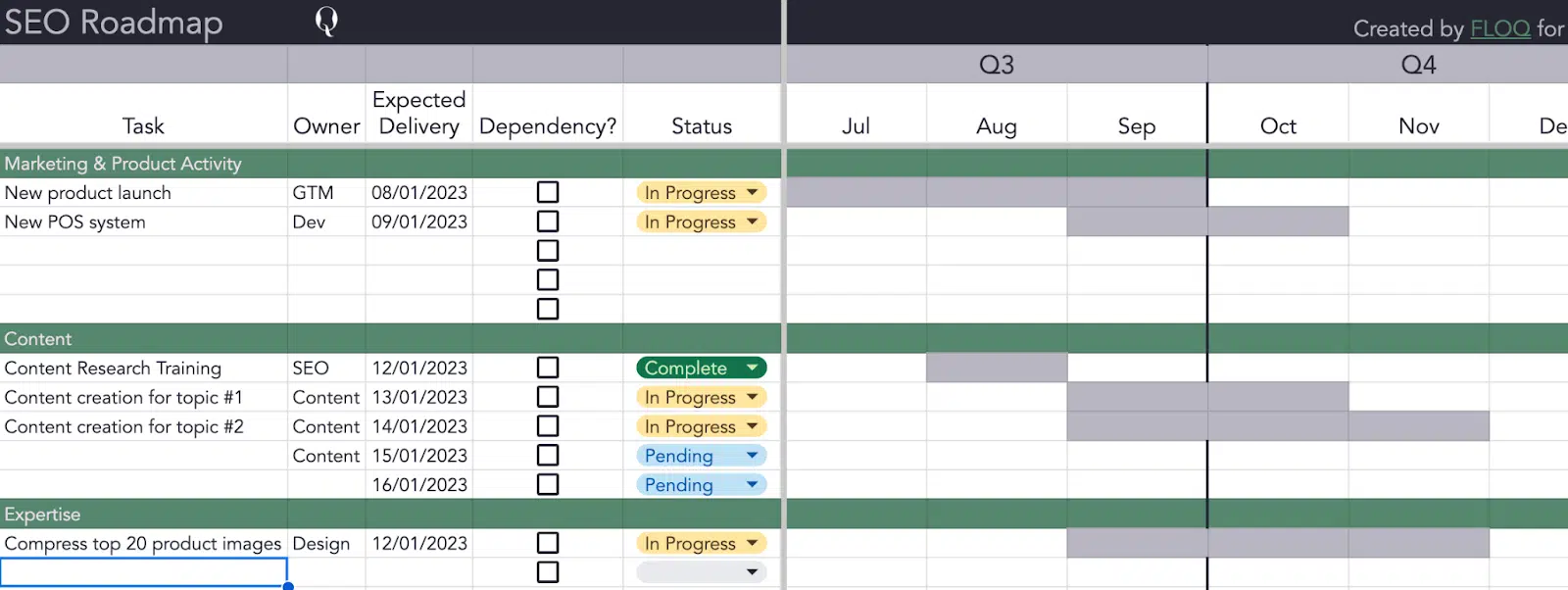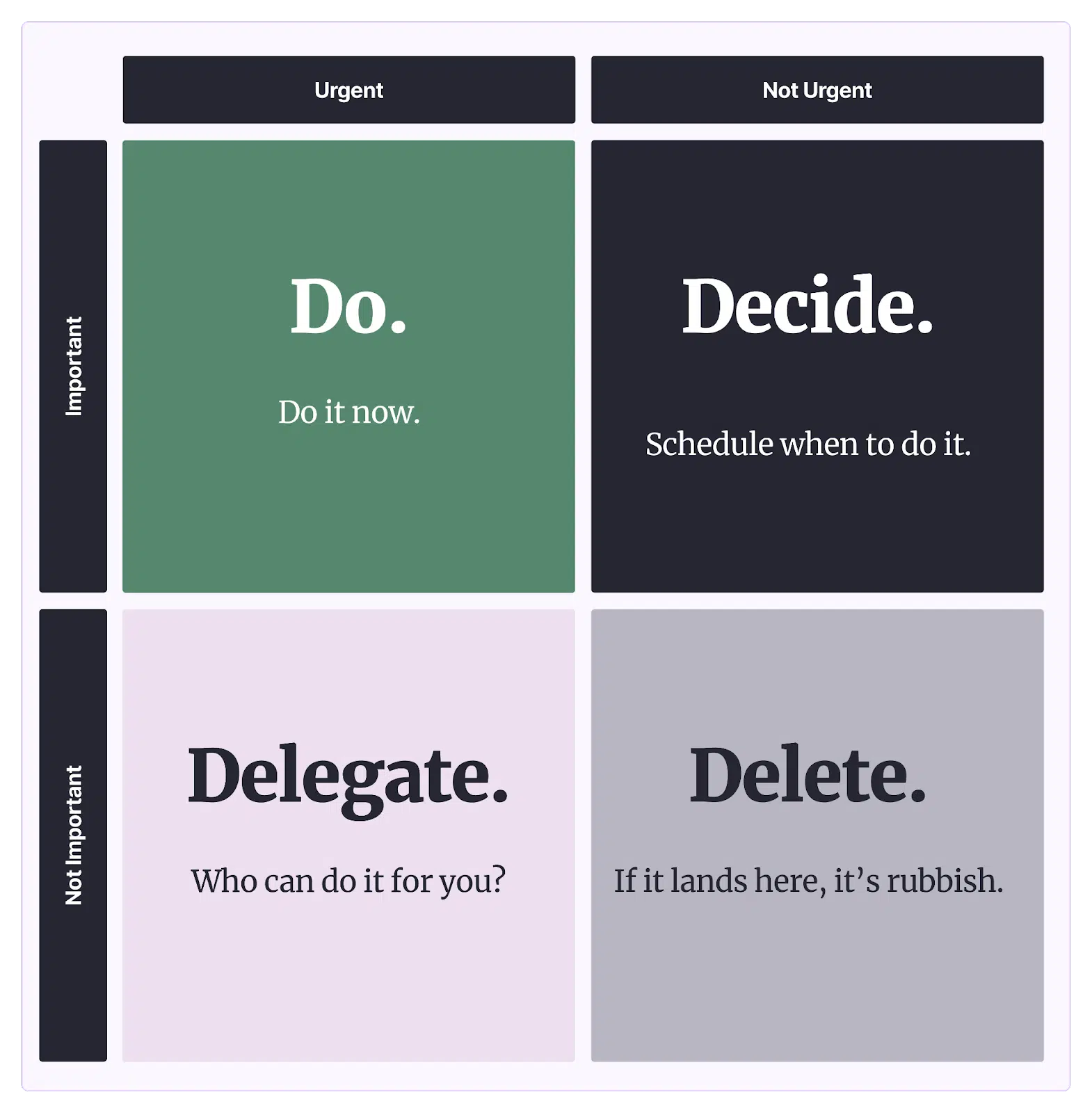Learn why an SEO roadmap is essential for your strategy, how to create one, and tips for prioritizing tasks and collaborating effectively.
When implementing an SEO strategy, a document roadmap is crucial for several reasons:
- It serves as your daily guide.
- It represents what non-SEO professionals perceive as SEO – a practical checklist of tasks.
- It provides a structure to communicate expectations with stakeholders.
A solid, well-researched strategy is best complemented with an SEO roadmap in Google Sheets or a tool like Jira or Asana. Ideally, leverage the technologies your teams are already using.
This article discusses why an SEO roadmap is essential for your strategy. Plus, learn how to create a solid SEO roadmap to prioritize tasks and collaborate effectively with teams.
What you need for an SEO roadmap


An SEO roadmap is a lot like SEO as a whole, it cannot successfully exist in a silo. That’s both in terms of your own research and your team within the wider business.
Within SEO, you’d ideally have a completed SEO strategy, which includes your:
- Technical audit.
- Content inventory, content audit and content gap analysis.
- Topical research – entity (including your own brand), keywords and topics.
- Market and competitor research.
Once you have all of that, you should be able to layer it on top of your wider business context. This includes:
- Your business goals for the next one to five years.
- Tools, people and budget availability. This includes knowing when and how you can pitch for budget.
- Planned product launches or marketing campaigns.
- Your technology stack and any known limitations, considerations, or planned changes (including migrations).
Gathering this information for your SEO roadmap is crucial because, initially, you’ll aim to tackle high-impact, low-effort tasks. Keep in mind that these tasks vary depending on your organization.
Understanding your business goals will:
- Help align your SEO “quick wins” with work that will actually directly benefit the bottom line of the business.
- Give you the ability to speak to that benefit when getting the work done.
Knowing the people, tools and budget available to you may push you to reconsider where you start with your roadmap.
Let’s say you’re launching a new product in the next three months, and your development team is totally at capacity until a month after that launches. Maybe you start with your content team and create new hub-and-spoke content within your organization’s area of expertise first.
For example, when I worked at Optus, a major telco in Australia, folks would be hard-pressed to get any new development done on the website, large or small, from about June to September because we were preparing for the iPhone launch.
(In that instance, I was a part of that launch team, so I had a bit more wiggle room to get stuff done than I would’ve otherwise, but you get the gist).
You’ll also want to get a grasp on your tech stack. For some tech stack configurations, particularly on smaller websites or with SPAs, implementing a 404 server response or a 301 redirect might seem straightforward but is much more difficult and time-consuming than standard.
It isn’t easy to generalize in SEO. So, while you may want to say that a high-impact, low-effort task would be to resize the 10MB images on your product pages (yes, I’ve seen this happen, and you probably have too), there may be a reason why your images are that large, or why they haven’t been compressed yet.
Having all this context before putting together an SEO roadmap becomes your early indicator of those sticky situations.
function getCookie(cname) {
let name = cname + “=”;
let decodedCookie = decodeURIComponent(document.cookie);
let ca = decodedCookie.split(‘;’);
for(let i = 0; i <ca.length; i++) {
let c = ca[i];
while (c.charAt(0) == ' ') {
c = c.substring(1);
}
if (c.indexOf(name) == 0) {
return c.substring(name.length, c.length);
}
}
return "";
}
document.getElementById('munchkinCookieInline').value = getCookie('_mkto_trk');
Steps to create your SEO roadmap
1. Prioritize
This is the first round of prioritization, the one where I estimate the SEO impact in a silo.
If I look at nothing else, the one metric I look at to help prioritize is how much of the website that potential issue affects.
Once I understand the scale, I look to estimate the impact. Quantifying impact can be difficult, but there are a few ways to do it:
- Top-down using competitor analysis and historical or current website changes as a model.
- Bottom-up using keyword-level forecasting based on estimated position changes.
- Traffic estimates using historical modeling and tactically based case studies or historical competitor execution.
While we can be secure in our scale and impact estimates for SEO, the one element we’re less certain of is effort.
I’ll still take a stab at estimating effort, but to do it well, I bring in the experts.
2. Assign and estimate
SEO can sometimes be like herding cats because you rely on other people or teams to implement your tactics.
This is why I start my roadmap with what some may feel is that last step – figuring out who’ll be doing the work and speaking to them about how long they think it will take.
If relevant, I’ll ask when they think they can do it and any other dependencies they’d need to do the work, like budget.
I’m not an expert in design, UX, or front-end development for our website. They are.
So, while I can build a rough estimate of what I think a task will take based on my own experiences with other clients or what the web generally says, it’s only a T-shirt size – one that could be off-base for reasons I don’t know.
I don’t know the legacy code we have stringing through the website or the fact that it can take up to an hour sometimes to replace images on a product page because of a buggy CMS that’ll randomly not apply filename changes sometimes.
I don’t know if we’re amidst an unofficial code migration or running 20x CRO tests on that page.
I don’t know all that stuff, but my teams do.
So I take my SEO strategy, which I’ve probably worked on for months, agonized and perfected, and I pull out all the tasks I think a particular team will do.
Then I take that and do a rough grooming and sizing session for those tasks with someone who knows what they’re talking about – usually, with the product owner of that squad.
And if you don’t know who that is, it’s a good time to make friends. I swear, 90% of being an SEO is about being curious and kind.
Note: Depending on your organization, your team might estimate differently. Sometimes, it’s in days. Other times, it’s using an agile Fibonacci scale or something similar.
Whatever it is, you’ll want to be consistent. A Fibonacci scale can make translating to days in order to estimate the time frame a bit more difficult. Still, I’d lean on the team to give an average execution time so you can then put in at least an estimated delivery.
This estimation process is helpful for enterprise-level companies because, assuming the conversation goes well, you’re essentially getting a soft yes from that team.
That’ll make it easier for them to say yes for real when the work comes across their desk later.
And then once that’s done, for me, it’s mostly paperwork.
3. Do the paperwork
For me, there’s no better format than Gantt when it comes to timed work and keeping track of it.
You can build it like I typically do in Google Sheets or use software-based versions in tools like Jira or Monday.
Define your headings
Your headings should be your primary work areas and can be based on your strategy.
For example, you may have buckets of work related to infrastructure, content or engineering.
For my strategy and roadmap, I typically align my primary areas of work to the teams that will primarily be handling them because that’s how my brain keeps track of things best.
Sometimes, aligning them differently, for example, with your business goals or team KPIs may make sense.
This could be something like “site speed, accessibility, expertise” where site speed and accessibility would primarily be development teams, and expertise would be a mix of SEO, development and content tasks.
Define your tasks
Everyone has a different perspective on what tasks should and shouldn’t be included in an SEO roadmap. Two major considerations are:
- How much you’re able to execute yourself.
- The level of detail you want and at what point it becomes overwhelming.
I typically work with enterprise clients, so in terms of tasks, there’s not usually much I can actually do myself.
What this means is my SEO roadmap is often a duplication of tasks that are assigned elsewhere, like JIRA tickets for developers or Asana tasks for designers.
The SEO roadmap becomes a centralized way for me to keep track of progress on SEO initiatives all in one place rather than a to-do list for me and my team to follow.
Let’ say you can execute much of the work yourself, then fabulous.
If tasks you can do yourself account for more than half the tasks in your roadmap, I’d suggest culling the list to focus on SEO work only and tracking non-SEO work either in a different tab in the spreadsheet or elsewhere.
For the granularity of tasks, aim for the middle ground – not too big and overwhelming, but also not too small and insignificant.
You wouldn’t want to include, say, “change the title tag on the blue widget page. But “change all title tags on the website” might be too large if you’re an enterprise site.
A middle ground could be, “Rewrite title tag formula for product page template, ” or even “Rewrite all title tag formulas.”
Something like “Product page optimization” could and should be broken into its component tasks, like:
- Create and share example product schema output for implementation.
- Create FAQ for top 20 revenue-driving products.
- Resize images for top 20 revenue-driving products.
- Work with content team to re-write product descriptions so they’re different from the manufacturer-provided ones for top 20 revenue-driving products.
From a practical perspective, if this is a year-long SEO roadmap, you want a manageable number of rows rather than hundreds or even thousands.
You’d likely get overwhelmed and end up not feeling confident getting started. Analysis paralysis is real.
4. Re-prioritize, assign and schedule your tasks
To use the SEO roadmap well, you need to treat it with laser focus. Once you have everything bucketed and tasked and know how long they’ll take to execute, it’s time to review your priority.
I prioritize tasks through a few different lenses after taking clear notes from my teams about dependencies and requirements for getting the work done.


First, the Eisenhower matrix.
This simple scale of the intersection of urgency and importance can be super grounding: more will probably end up in the “delete” bucket than you think.
I generally put these in a list in my notebook or project management tool I call “If/When I Have Time.”


This is after the initial grooming with execution teams, which probably discussed a few tasks or elements of tasks I realized weren’t worth the effort for the impact they would have.
I then come back to my initial prioritization and factor in the effort estimation from my teams.
- Does their feedback change my estimate of the impact?
- Did their expertise change my understanding of the scale?
Finally, we come back to the start. With tasks re-prioritized from actual feedback from the folks that’d be doing the work, it’s time to get the ball rolling.
This is when I tap execution teams on the shoulder to let them know this work should be coming their way and confirm they’ll be the ones to execute.
I start those “let’s make this official” for the tasks scheduled for the next six weeks, which, if all has gone well, should be those low-effort, high-impact tasks.
Drive SEO results with a well-defined roadmap
In case you weren’t sure, yes, this is a cycle. There’s a reason I started and ended my suggested process with similar tasks around assigning and estimating.
A strong SEO roadmap often moves and adjusts to what’s happening in the business and on the Internet. It’s an agile, living document.
When creating an SEO roadmap, my advice is to:
- Have a clear picture of the business and market context.
- Prioritize tasks first based on your SEO expertise.
- Re-prioritize tasks based on estimations and feedback from the executing teams.
- Organize your roadmap based on business goals or execution teams.
- Be focused on which tasks are actually valuable.
- Remember this is different from your day-to-day task list. Detailed page-level tasks should probably be kept out of the task list.
- Revisit the roadmap regularly.
With all that in mind, you’re armed to build a strong and flexible SEO roadmap for your clients, your business or your employer.
Opinions expressed in this article are those of the guest author and not necessarily Search Engine Land. Staff authors are listed here.
Related stories
New on Search Engine Land
@media screen and (min-width: 800px) {
#div-gpt-ad-3191538-7 {
display: flex !important;
justify-content: center !important;
align-items: center !important;
min-width:770px;
min-height:260px;
}
}
@media screen and (min-width: 1279px) {
#div-gpt-ad-3191538-7 {
display: flex !important;
justify-content: center !important;
align-items: center !important;
min-width:800px!important;
min-height:440px!important;
}
}
googletag.cmd.push(function() { googletag.display(‘div-gpt-ad-3191538-7’); });
–>
Original Source: How to create an SEO roadmap